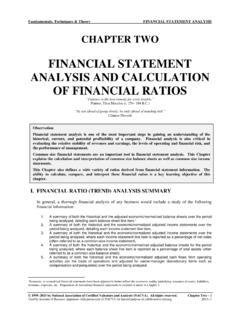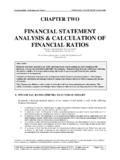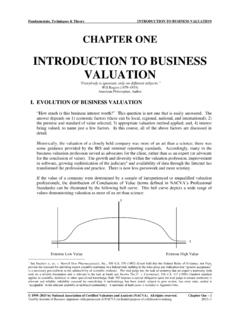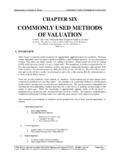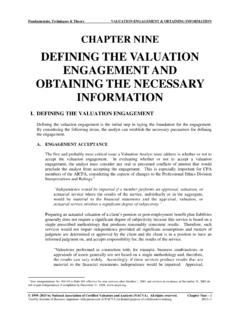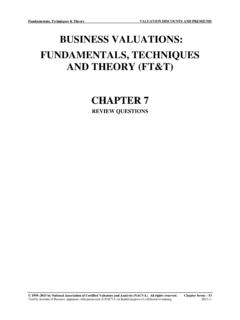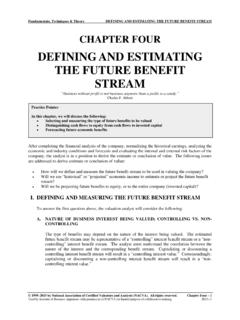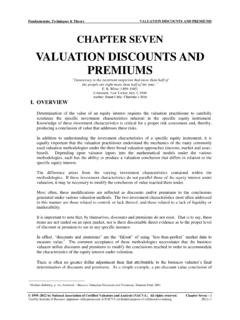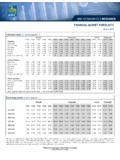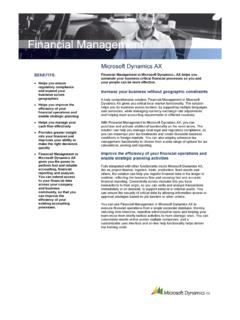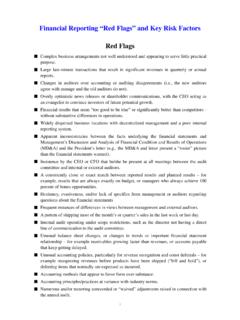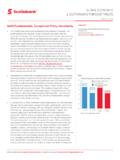Transcription of GENERATING ECONOMIC/NORMALIZED …
1 Fundamentals, Techniques & Theory ECONOMIC/NORMALIZED financial STATEMENTS 1995 2015 by National Association of Certified Valuators and Analysts (NACVA). All rights reserved. Chapter Three 1 Used by Institute of Business Appraisers with permission of NACVA for limited purpose of collaborative training. CHAPTER THREE GENERATING ECONOMIC/NORMALIZED financial STATEMENTS There are plenty of good five-cent cigars in the country. The trouble is they cost a quarter. What this country needs is a good five-cent nickel. Franklin Pierce Adams I. GENERATING economic / normalized financial STATEMENTS A. OVERVIEW Performing a thorough analysis of the historical (and resulting economic ) financial statements of a business is prerequisite to performing a meaningful and thorough valuation. Basic financial statements include the balance sheet, income statement, and statement of cash flows.
2 A thorough analysis of these statements1 is required in any valuation of a closely held business or business interest. A complete financial analysis of the business will assist the analyst in many ways including, but not limited to, the following: 1. Helping to identify strengths and weaknesses of the business 2. Helping to identify trends of the business over time 3. Allowing the valuation analyst to compare and analyze the subject company s historical performance and providing a basis for comparing the business to other similar businesses or industry averages 4. Help identify areas for potential normalizing adjustments A thorough financial analysis will allow the analyst to draw conclusions relating to key financial variables critical to the valuation of a closely held business while allowing the analyst to quantifiably support those conclusions. financial analysis should be initially performed prior to making economic adjustments, as an aid in identifying potential areas of adjustment.
3 financial analysis should also be performed after adjustments are made. 1 NACVA s valuation software, called Business Valuation Manager Pro (BVMPro), is a good place to start your valuation s financial analysis. ECONOMIC/NORMALIZED financial STATEMENTS Fundamentals, Techniques & Theory 2 Chapter Three 1995 2015 by National Association of Certified Valuators and Analysts (NACVA). All rights reserved. Used by Institute of Business Appraisers with permission of NACVA for limited purpose of collaborative training. B. NECESSARY INFORMATION In order to perform an adequate financial analysis, the analyst will require certain information from the client. This information should include, but not be limited to: 1. financial information (historical and prospective) and other similar data on the subject company 2.
4 Factual history of the company 3. Information about perceived competitors 4. Management s expectations and perceived strengthens and weaknesses The analyst should use a checklist when requesting and obtaining documents and information. A sample checklist is included in Appendix IV of this manual. Even though the analyst may not require all of the items on the checklist, or may require some additional items, a checklist should still be used as an aid to organization and administration over this portion of the engagement. The availability of audited or reviewed financial statements (as opposed to compiled statements or tax returns) sometimes leads the analyst to place a high degree of confidence in the statements. However, as will be discussed later in this chapter, GAAP rarely equates to true economic value.
5 Therefore, adjustments for purposes of valuation are often made to even unqualified audited financial statements. There is no universal method for analyzing a company s financial statements. Each analyst will begin at a different point, but no area can be skipped. It is important for the analyst to evaluate all the information provided so a decision to use or not to use any of the data is conscientiously and deliberately made. C. ECONOMIC/NORMALIZED financial STATEMENTS It is often assumed that a good estimate of the value of a closely held business can be made by merely looking at the company s most recent balance sheet or income statement. This is certainly not the case. It is commonly accepted that most financial statements, even if prepared using Generally Accepted Accounting Principles (GAAP) or using a Tax Basis of Accounting (TBA), often present a picture that is very different from economic reality.
6 As a result, the analyst will generally prepare economic or normalized financial statements. normalized financial statements will allow the analyst to better compare the subject company s financial performance and position to similar companies or industry averages. It also allows the analyst to better measure true economic income, assets and liabilities. Practice Pointer Rev. Rule 59-60 suggests five years or more of data should be considered; perhaps this figure was used since it approximated the average business cycle. In this global economy it is imperative that the valuation analyst understand the subject firm s business cycle as well as the local, regional, and in certain instances, the international economy and how these impact the subject firm s industry, because accordingly, the period to analyze could be longer or shorter, based on the analysts judgment.
7 Fundamentals, Techniques & Theory ECONOMIC/NORMALIZED financial STATEMENTS 1995 2015 by National Association of Certified Valuators and Analysts (NACVA). All rights reserved. Chapter Three 3 Used by Institute of Business Appraisers with permission of NACVA for limited purpose of collaborative training. 1. Objective The main objective for recasting or adjusting the financial statements of a closely held company can be stated as follows: To adjust the financial statements or income tax returns of a business to more closely reflect its true economic financial position and results of operations on a historical and current basis. Balance sheet adjustments are made to reflect the current market values of both assets and liabilities. Income statement adjustments are made to reflect the true economic results of operation similar to what a prospective buyer might require to have reasonable knowledge of the relevant facts.
8 Normalizing adjustments are hypothetical and are not intended to present restated historical results or forecasts of the future in accordance with AICPA guidelines. 2. Purpose of ECONOMIC/NORMALIZED financial Statements a) Should be useful for making comparisons to similar business or industry averages b) Should be useful in making meaningful projections and forecasts c) Should result in a representative level of benefits d) Should (as nearly as possible) represent market values of net assets 3. Categories (or Areas) Of Normalization Adjustments Normalizing adjustments generally fall into these categories: a) Method of accounting (LIFO, FIFO, Weighted Average) b) Non-recurring (transactions that are not reasonably expected to recur in the foreseeable future) c) Non-operating/operating (this includes removal of non-operating assets and liabilities and their related earnings and/or expenses from historical financial statements) d) GAAP compliance Many normalizing adjustments cross boundaries.
9 The analyst should be alert to the potential issues. Common examples encountered by analysts include: a) Accounting under GAAP (Generally Accepted Accounting Principles) or TBA (Tax Basis Accounting) or a combination thereof often results in a distorted picture of economic reality b) Closely held business financial statements frequently have the following characteristics: (1) Highly aggressive expensing policies to reduce income taxes (2) Historical or cost basis in nature ECONOMIC/NORMALIZED financial STATEMENTS Fundamentals, Techniques & Theory 4 Chapter Three 1995 2015 by National Association of Certified Valuators and Analysts (NACVA). All rights reserved. Used by Institute of Business Appraisers with permission of NACVA for limited purpose of collaborative training. c) economic ( normalized ) financial statements can be costly to generate: (1) Supportable data just may not be available (2) Unfortunately, often results in adjusting those items that are relatively easy to support or easy to identify.
10 The valuation analyst should spend enough time interviewing management to identify those areas most likely in need of adjustment. This will likely require some research to ascertain the norms and eccentricities of the industry for the subject company d) Excessive compensation, perquisites, rent and similar effects of current ownership e) Non-controlling (minority) vs. Controlling interest adjustments (1) Some valuation analysts believe that when valuing a non-controlling interest, those elements of the financial statement over which the non-controlling interest has no control should not be adjusted; others debate the appropriateness of adjusting an owner s compensation II. GAAP ACCOUNTING VERSUS economic ACCOUNTING A. GAAP PRINCIPLES THAT POTENTIALLY DISTORT TRUE economic VALUE "..within the framework of generally accepted accounting principles (GAAP), there is some latitude permitted in the preparation of financial statements.
